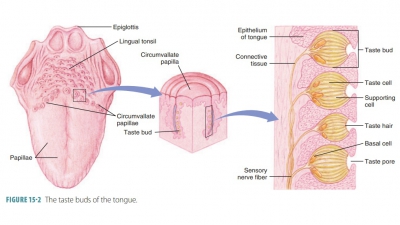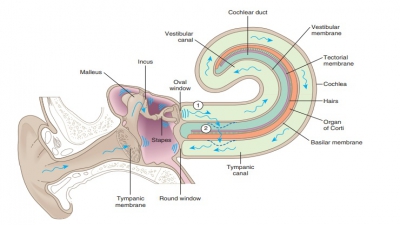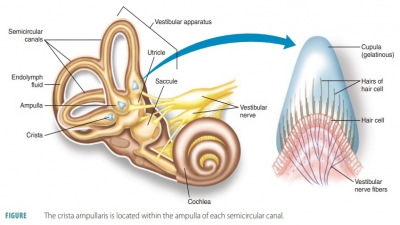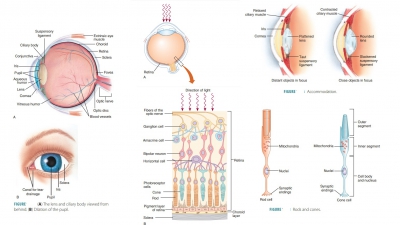Sense of Smell
| Home | | Anatomy and Physiology | | Anatomy and Physiology Health Education (APHE) |Chapter: Anatomy and Physiology for Health Professionals: Special Senses
The upper nasal cavity contains smell (olfactory) receptors.
Sense of
Smell
The upper nasal cavity contains
smell (olfactory) receptors. The sense of smell works closely with the sense
of taste. The olfactory organs are yellow-brown masses of pseudostratified epithelium covering the
upper part of the nasal cavity, the superior nasal conchae, and part of the
nasal septum. The lamina propria makes up the olfactory organs. Bipolar neurons
surrounded by column-like epithelial cells are called olfactory recep-tor cells (FIGURE
15-1) or olfactory sensory neurons. The
dendrites of these neurons are covered at the distal end by hair-like and
mostly stationary cilia, which greatly increase the receptive surface area.
Mucus from the olfactory glands helps
to capture and dissolve airborne odorants. The sensory neurons are surrounded
and cushioned by supporting cells that are columnar in arrangement. Short olfactory stem cells lie at
the base of the olfactory epithelium. Unlike many other sensory neurons, those
involved in olfaction are often damaged, with a life span of only 30–60 days.
They are replaced when olfactory stem cells in the olfactory epithelium
differentiate. Odorant molecules
stimulate varieties of olfactory receptor proteins to differenti-ate between
odors. These molecules must partially condensate from gases to fluids before
receptors can detect them. The receptors of both smell and taste are chemoreceptors. These two senses
complement each other, responding to different
groups of chemicals.
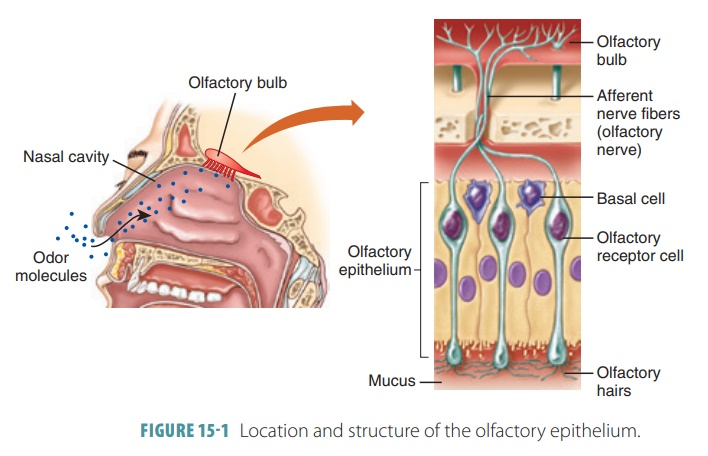
Olfactory receptor cell fibers
synapse with neu-rons located in the enlarged olfactory
bulbs, which lie on either side of the
ethmoid bone. These bulbs analyze impulses, which are transmitted along the
olfactory tracts to the limbic system. Most smells are interpreted in the
olfactory cortex within the tempo-ral lobes of the brain and at the lower
frontal lobes in front of the hypothalamus. Filaments of the olfactory nerves
synapse with mitral cells, which are actually second-order sensory neurons. This occurs in
complex olfactory glomeruli. Activation of the mitral cells causes impulses to flow from the
olfactory bulbs through the olfactory tracts, or local integrators. Odors are
consciously interpreted and identified to the part of the frontal lobes just
above the orbit, and only some of this information reaches the thalamus.
Another path-way reaches the hypothalamus, amygdala, and other limbic system
regions. Emotional responses to smells such as gas or smoke may be elicited
there, triggering the fight-or-flight response. Salivation and digestive tract
actions are stimulated by appetizing odors. Pro-tective choking or sneezing
reflexes may occur if an unpleasant odor is detected.
Olfactory stimulation occurs as
biochemical pathways are activated, allowing an influx of sodium ions,
triggering an action potential. There are several hundred types of olfactory
receptor cells. They can bind to several types of odorant molecules and vice
versa. Because the olfactory organs are high up in the nasal cavity, faint
odors may be difficult to perceive. The sense of smell is more intense with a
new odor at first, fading over time. Because the olfactory epi-thelium is
located high up in the nasal cavity, it is not as efficient in detecting
certain odors as it is in other animals. Sniffing the air pulls more odorant
molecules across this epithelium, intensifying olfaction. Olfac-tion occurs
when a molecule binds to the surface of an olfactory cilium. Olfactory receptor
cells have a short life span, of about 60 days.
A single odor may be made up of
hundreds of chemicals. Unlike the sense of taste, the sense of smell is not
easily classified with regard to how it works. Our olfactory sensory neurons
are stimulated by different combinations of olfactory qualities, which together
can allow us to distinguish approximately 10,000 odors. In the human nose,
about 400 “olfactory genes” are active, with each gene encoding a unique
receptor protein. Each protein is believed to respond to one or more odors,
with each odor binding to several different types of receptors. Only one type
of receptor protein, however, belongs to each receptor cell. Nasal cavities
also contain temperature and pain receptors that are affected by irritants.
Sharp, cooling, or spicy irritants create impulses from these receptors, which
reach the CNS through trigeminal nerve afferent fibers. To smell a certain
odorant, it must be in a gaseous state (vola-tile) as it enters the nasal cavity.
It must also dissolve in the fluid that coats the olfactory epithelium.
Olfactory receptor cells are the only neurons that are replaced throughout
adult life.

